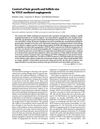Induction of Cardiomyocyte-Like Cells from Hair Follicle Cells in Mice
March 2019
in “
International Journal of Molecular Medicine
”
TLDR Mouse hair follicle cells can become heart-like cells without genetic changes.
The study demonstrated that hair follicle (HF) cells from 8 mice could be induced to differentiate into cardiomyocyte-like cells in vitro without genetic modification. By culturing HF cells on OP9 feeder cells in KnockOut-Dulbecco's modified Eagle's medium/B27 with vascular endothelial growth factors, the cells expressed cardiac-specific markers and exhibited spontaneous beating for over 3 months. This suggested that HF cells could be a potential source for generating cardiac lineage cells, offering a promising avenue for stem cell-based therapies in tissue and organ regeneration, particularly for cardiac applications. The study emphasized the need for cardiac-specific differentiation protocols to avoid producing other cell types.

